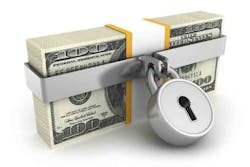You can spend your entire life building your business, accruing your wealth and setting your family up for the future.
But in one instant, a lawsuit can erase all that hard work.
When it comes to protecting your assets, Larry Oxenham knows there’s always more work and preparation to be done in order to preserve your wealth for yourself and your family. And while there are certain principles that apply to all business owners and protecting their assets, Oxenham knows—through courses he has instructed at the Automotive Management Institute—that the potential threats to a body shop owner’s assets are unique.
“Body shop owners have a different situation because they have customers often on-site, which creates a new level of liability,” says Oxenham, senior advisor for the American Society for Asset Protection (ASAP). “So as much as they try to keep the customers out of certain areas of liability, they have auto rebuilds that could have damage, they have employees that create repairs that could lead to problems.”
Oxenham recently worked with a body shop owner who is being sued by an employee who developed an allergy from the chemicals used to mix paint.
“Who expects lawsuits like that?” Oxenham asks. “What we do [at ASAP] is ‘legal toothbrushing.’ We believe in trying to prevent the lawsuit in the first place. We take all the incentive away from the attorney to the point that if they win, they may get punished financially. Because of that, there is little incentive to file the lawsuit. You don’t have to worry about your business being interrupted, you don’t ever look over your shoulder. You can’t prevent lawsuits, but if you take the reward out for the attorneys, the lawsuit stops.”
Oxenham says lawsuits in America have grown at an astronomical rate in recent years. That’s why ASAP has combined the strategies utilized by the wealthiest people in America to provide legal assistance to business owners for protecting and preserving their assets, and learn how to make yourself so unattractive to a plaintiff’s attorney that they will not be motivated to pursue a lawsuit against you.
The key to truly protecting your assets? Properly setting up your shop as a limited liability company (LLC).
Setting Up an LLC
Oxenham’s philosophy and strategy for protecting your assets stems from a famous quote from Donald Trump: You have to control everything, but you can’t afford to own anything.
“Trump’s advice is perfect for any business,” Oxenham says. “You need to have control, but you can’t afford to own because what you own is what goes into a lawsuit.”
Before the Uniform Limited Liability Company Act was adopted in 1996, limited partnerships were the main method of protecting assets. A limited partnership is a form of partnership similar to a general partnership, except that in addition to one or more general partners, there are one or more limited partners. It is a partnership in which only one partner is required to be a general partner.
In 1977, the Wall Street Journal declared that a limited partnership is the only surefire, 100-percent controllable way of protecting your assets. This declaration was in reaction to the 1977 IRS ruling 77-137, which was trying to find a way to make money off profits in limited partnerships.
“The limited partnership is a really unique creature because you can be legally schizophrenic,” Oxenham says. “You can be both the general and limited partner. That’s how you separate the liabilities. The general partner is usually the one that has 100-percent control and makes decisions. But the limited partner typically is going to own assets.”
What Oxenham’s company does is incorporate the asset-protecting qualities of a limited partnership into an LLC agreement, which can be so specifically worded and tightly controlled that it’s difficult for either the IRS or the plaintiff’s attorney to find wiggle room and go after your assets.
Say you have $2 million in assets, perhaps through buildings or land, that cannot be touched. However, you also have $100,000 of profit you and your family is living off of, and you intend for that profit to continue.
“Well, [the plaintiff is] entitled to your money,” Oxenham explains. “And they leave the lawsuit on the books, and they get your money this year and next year, and they get it until they’re completely paid off. Well, that takes the fun out of having a limited partnership, because even though they couldn’t take your assets, they can take your money, so it’s kind of an empty victory.
“However, if you have our limited partnership built primarily for asset protection, we have a paragraph that gives you the general partner some decision making authority.”
This particular paragraph in the LLC agreement states that the general partner—which would be the owner attempting to protect his or her assets—“reserves the right to withhold all distributions of profit.” Oxenham says this allows the general partner to be the “absolute dictator” in a limited partnership and make all decisions about cash distribution when the lawsuit is handed down.
“So now put this in perspective,” Oxenham says. “You’re an attorney and you’ve sued somebody. Not only did that person not have to pay, you ended up getting liable for the tax bill. So if you are an attorney and you search the public record against somebody and you saw this limited partnership, what would you do?
“Attorneys have often said we’re a target-rich environment in America, meaning there are millions of people to sue. But if you put a barrier in front of you, the attorney will move right onto the next person.”
Key Assets in an LLC Agreement
There are five key assets Oxenham says a business owner must consider covering when incorporating limited partnerships into an LLC agreement: home assets, real estate assets, safe assets, business assets and appreciated assets. While not all of these assets, which each get their own limited partnership, are pertinent to each and every business owner, Oxenham says it’s important to understand each one and if they could potentially contribute to accruing wealth.
• Home Assets: Oxenham says that, in most cases, the home is the most valuable asset, so it’s key to set up the home in the agreement.
“If mom and dad are getting old and they want to continue living in the home, they simply retain one-percent ownership and give 99 percent to the kids,” Oxenham explains. “But [the parents] act as a general partner. So it doesn’t change their lifestyle, it doesn’t cause any hardship for them. They’ve just got a better legal tool in place to protect them.”
• Real Estate Assets: Real estate assets could involve anything you own. Because of its value, it also belongs in the LLC agreement.
“You’ll start to notice a theme here,” Oxenham says. “We like to separate our assets into separate limited partnerships, so if one gets sued we don’t get everything tied up in the same partnership.”
• Safe Assets: While they do not carry a high likelihood of lawsuit risk, your safe assets, such as stocks, mutual funds, bonds, bank accounts and your personal residence, are vulnerable in a lawsuit.
“Chances are your art collection or the coins you have tucked away in a corner are going to remain silent,” Oxenham says. “But you don’t want them taken if there’s a lawsuit.”
And while grouping those personal assets into a limited partnership protects them while you’re alive, what happens when you pass on?
“Well, you’re going to have to instruct the LLC that when you pass on, everything that’s sitting in those limited partnerships is going to go into your living trust,” Oxenham explains. “So now you’ve got the greatest protection you could ever have while you’re alive, and now everything moves over to the living trust when you pass on and it’s settled out of the estate. The living trust prevents the possibility of probate, it gets things to the kids right away, it just removes that uncertainty you have for the future.”
• Business Assets: Both your business and appreciated assets grow in value over time. Oxenham says that, in order to preserve that growth, you’ll want to use your tax deductions to allow your corporation to serve as the general partner in the limited partnership.
Then you’re going to put your business assets, whether it be equipment or machines that go up in value over time or cause high risk for your business, inside your limited partnership to give them absolute protection.
“Now that you’ve got your business assets in the partnership to protect them, you’re going to let the corporation manage the assets and lease it from the corporation,” Oxenham says. “So you’ll give yourself spectacular tax benefits along with the greatest protection you can have in America today.”
• Appreciated Assets: When it comes to planning long term, protecting your appreciated assets—which are assets at a higher market value than its book value or taxable value, and which, upon its sale, will generate a capital gain—is key, Oxenham says.
If you own something that is fully appreciated and cannot be utilized for any more tax deductions, the cash being accumulated from those assets can be passed on to your family by setting up a charitable remainder trust.
“The charitable remainder trust gives you great asset protection because now the charity owns the asset instead of the family owning the asset and it’s going to continue to grow in there,” Oxenham says. “It grows tax-free while it remains in the trust and the two of you can manage that trust.”
And when you sell your business or retire, the charitable remainder trust stays there and gives you great asset protection, Oxenham explains.
“You can take out up to 10 percent of it per year to live on,” Oxenham says. “And then, because you want your assets to remain in the family, you’re going to set up the family foundation for the benefit of your family, so that now everything that you’ve accumulated over your lifetime is going to be passed on to your family.”

